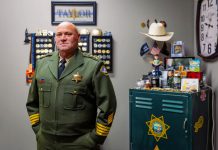When the wild’s call proves too much
Most people I know have some experience with going into the
wild, some more than others. For me my experiences with wilderness
were mostly limited to summer camping trips not far from home at
Mount Madonna Park or Coyote Lake. The trips were all about running
around in the mountains or playing on the rocky shore of the lake.
The meals consisted of things not much different than we might eat
at home, except for the abundance of marshmallows for toasting.
We’d play board games on the picnic tables at our camp site, and my
dad would take my sister, cousins and I on hikes along the trails,
where we all searched for the perfect walking stick my dad would
carve and smooth out for us.
When the wild’s call proves too much
Most people I know have some experience with going into the wild, some more than others. For me my experiences with wilderness were mostly limited to summer camping trips not far from home at Mount Madonna Park or Coyote Lake. The trips were all about running around in the mountains or playing on the rocky shore of the lake. The meals consisted of things not much different than we might eat at home, except for the abundance of marshmallows for toasting. We’d play board games on the picnic tables at our camp site, and my dad would take my sister, cousins and I on hikes along the trails, where we all searched for the perfect walking stick my dad would carve and smooth out for us.
My interest in roughing it passed pretty early on since I prefer the luxuries of home, including running water, daily showers and refrigeration. The summer camping trips ended after I became a teenager. But there is something about the wild that calls to some people so much they are willing to risk their lives to answer it.
“Into the Wild,” which was recently released on DVD, is based on a book by Jon Krakauer of the same name. Krakauer’s non-fiction story follows the journey of Christopher McCandless (played by Emile Hirsch in the movie). McCandless graduated from Emory University at the top of his class and had a promising future when he gave up $24,000 in savings to Oxfam, left behind his family and possessions, and decided to travel around the wilds of America. His eventual goal was to live in Alaska.
Krakauer pieces together McCandless’ journey from letters, journals he kept and interviews with the people he met along his travels. In the movie, director Sean Penn replaces Krakauer’s narrative with an interspersing of narration by McCandless and his younger sister Carine (Jena Malone).
Watching the movie is a practice in frustration as I knew the ending of this true story. McCandless dies alone in Alaska, probably of starvation or possibly from poisoning himself. According to the book, his body weighed 67 pounds when it was discovered by moose hunters weeks after he died.
McCandless has money enough to support himself when he starts his travels, but he turns away from it and chooses to hike on foot, kayak or hitchhike.
Along the way McCandless carries books with him by authors such as Jack London, Henry David Thoreau and Leo Tolstoy. It is suggested that the writers influenced his decision to travel on his own. Penn also plays up a bad relationship between McCandless and his parents as an explanation for his rejection of society and human connection. He changes his name to Alexander Supertramp and burns all his ID cards.
What McCandless fails to understand is that even on his own, he seeks out relationships with others. He happens across many people along his journey, but he returns to some of them over the two years until he makes it to Alaska.
He meets Jan Burres (Catherine Keener) and Rainey (Brian Dierker) while hiking the Pacific Crest Trail. They are travelers themselves, though they live in an RV. They accept McCandless into their lives and invite him to meet up with them again in the California dessert. In the movie, Jan looks after McCandless as a mother figure. She encourages him to call his family and let them know he is OK. She has a son herself, who she hasn’t seen in a few years – his choice, not hers.
McCandless also spends time working in South Dakota, a place he returns to the second year on his own. He takes menial jobs from time to time to raise money for supplies and to travel. He also meets an old man named Mr. Franz (Hal Holbrook) near the desert while he prepares for his trip to Alaska, and they both have an impact on each other.
One of the best things about the movie is the cinematography. The movie was filmed in more than two dozen locations from Georgia to the Western United States to Alaska. The result is that movie-goers get a very clear sense of where McCandless spent his time and get to see what drew him in. The movie is best viewed on a high-definition television or in a theater so that the scenery can really be appreciated.
The views of Alaska are amazing, but it is heartbreaking that after two years of preparing, McCandless still goes to Alaska poorly armed. He has just a bag of rice, a rifle and a book on edible plants when he takes up residence in an abandon bus far from civilization. The end seems inevitable and should be a reminder to others that it’s called the wild for a reason.









